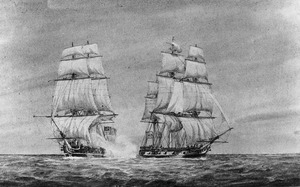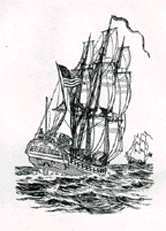Capture of HMS Savage facts for kids
Quick facts for kids Capture of HMS Savage |
|||||||
|---|---|---|---|---|---|---|---|
| Part of the American Revolutionary War | |||||||
 Painting of American privateer Congress capturing HMS Savage |
|||||||
|
|||||||
| Belligerents | |||||||
| Commanders and leaders | |||||||
| Strength | |||||||
| 1 sloop-of-war | 1 sloop-of war | ||||||
| Casualties and losses | |||||||
| 11 killed ~30 wounded 1 sloop-of-war damaged |
8 killed 26 wounded 1 sloop-of-war captured |
||||||
The Capture of HMS Savage was an important naval battle during the American Revolutionary War. It happened in September 1781. This fight was between an American ship called Congress and a British ship named HMS Savage. It took place near South Carolina in the Atlantic Ocean. Many people consider it one of the toughest single-ship battles of the war.
The Ships and Their Commanders
By 1781, smaller British ships were blocking Chesapeake Bay. They often raided the American coast. One British commander involved in these raids was Captain Charles Stirling. He commanded the sloop HMS Savage. This ship had sixteen 6-pounder cannons. Captain Stirling was known for raiding Mount Vernon. This was the home of General George Washington. Washington was the leader of the Continental Army and later the first American president.
Shortly after the raid on Mount Vernon, Captain Stirling sailed his ship south. On the morning of September 6, HMS Savage was protecting other ships. Then, it met the American ship Congress. This was about 30 miles (ten leagues) from Charleston. Stirling quickly moved Savage to protect the merchant ships from the stranger.
The American ship Congress was a privateer. A privateer was a private ship given permission by the government to attack enemy ships. It was commanded by Captain George Geddes from Philadelphia. Congress was a powerful ship. It had twenty 12-pounder cannons and four 6-pounder cannons. It also had a large crew of 215 officers and sailors. Its Marines were led by Captain Allan McLane. Congress was returning from Cap-François, Haiti. Captain McLane had delivered important messages there. These messages were from George Washington to a French fleet commander, asking for help at Chesapeake Bay.
The Battle Begins
When Captain Stirling first saw Congress, he sailed towards it. He hoped it was a smaller privateer that had been raiding the area. But as he got closer, he saw that Congress was much stronger. Stirling then tried to escape. However, by 10:30 AM, the American ship was close enough. Congress started firing its front cannons.
By 11:00 AM, Congress had closed the distance. Its crew began firing muskets and pistols. The British crew fought back with great energy. Captain Geddes noticed that his ship was faster. So, he moved Congress ahead of Savage. He got almost next to the British ship. This was to prepare for a powerful broadside attack. A broadside is when a ship fires all the cannons on one side at once.
A Fierce Fight
A close-range battle then began. Both ships were badly damaged. Sailors on both sides were even burned by the flashes of the enemy's cannons. Congress had its ropes and sails badly torn during this fight. This forced the Americans to pull away for quick repairs.
After fixing their ship, they started chasing Savage again. Congress quickly got alongside Savage once more. Another fierce battle began. The Americans and British fought for about an hour. The combat ended with Savage in ruins. Its upper decks were completely cleared of fighters. Its rear mast was blown away. The main mast was also almost gone.
Captain Geddes thought this was a good time to board the enemy ship. Boarding means jumping onto the enemy ship to fight hand-to-hand. But just as he was moving his ship closer, a British sailor appeared. He was on Savage's front deck. He waved his hat as a sign of surrender.
The British forces lost eight men killed. Thirty-four were wounded, including Captain Stirling. The Americans had 11 killed and about 30 wounded. Captain Stirling later wrote that the Americans treated him and his men "with great Humanity" after they became prisoners.
What Happened Next
In America, people cheered loudly about the capture. They saw it as getting even for Captain Stirling raiding George Washington's home.
However, the American sailors who boarded Savage never made it back to port. Another British ship, the frigate HMS Solebay, recaptured Savage on September 12. There were thirty American prize crew members on board. A prize crew is a group of sailors who take over a captured enemy ship.


